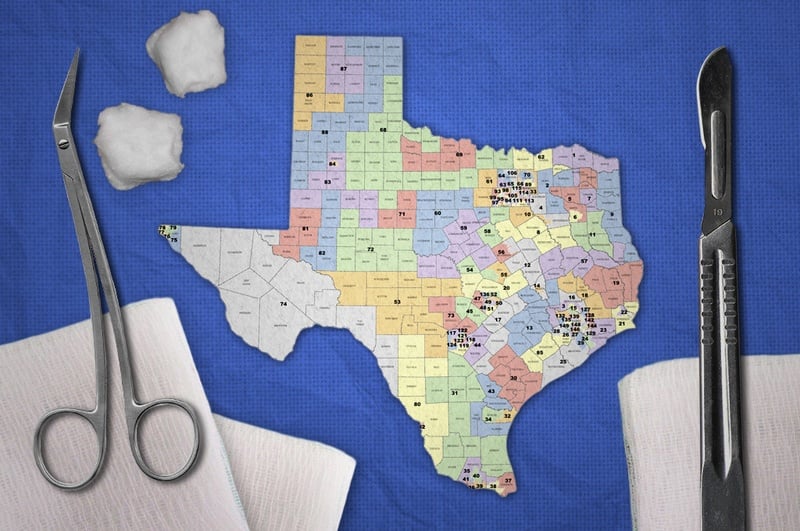This will be the main event of the week.
Eight months ahead of the 2018 primaries, Texas and its legal foes on Monday will kick off a week-long trial that could shake up races across the state.
The state and minority rights groups have been squabbling for six years over new political district boundaries drawn following the 2010 census. As part of a long-winding legal battle, a panel of three federal judges this week will reconvene in a federal courthouse here to consider the validity of the state’s political maps and whether changes should quickly be made to the state’s House and Congressional boundaries ahead of the midterm elections. At issue is whether the current boundaries violate the voting rights of millions of Texans of color.
The showdown comes months after the panel of judges found fault with the state’s 2011 drafts of the political maps. In a pair of rulings this spring, the judges also found that Texas lawmakers intentionally discriminated against minority voters in crafting them.
Those rulings did not require an immediate remedy because the state has been running elections since 2013 under court-drawn maps that were crafted amid an election scramble and later adopted by the Legislature.
But the judges are now turning their attention to the existing boundaries.
There’s an overview of how we got here and what is at stake in that story and also in this Statesman story, which notes the time factor:
Don’t expect immediate gratification. When the trial closes Friday or Saturday, the judges will take the matter under advisement — though a written ruling is expected relatively quickly as the court labors under looming election deadlines.
State officials have advised the court that any new maps would have to be ready by around Oct. 1 to meet deadlines for setting precinct lines and to allow candidate filing for the 2018 primaries to begin, as scheduled, in mid-November. Complicating the timing will be the inevitable appeal that the losing side will make directly to the U.S. Supreme Court.
If new maps are needed, the judges likely will order additional input on how to redraw district boundaries, lawyers said Friday.
The maps in question are the Congressional and State House maps that were implemented in 2013. Those maps in turn are basically identical to the interim maps created in 2011 after preclearance was rejected; the Lege adopted them with a couple of tweaks. The state claims that since the current maps are based on ones that had been drawn by the court, they cannot be discriminatory. The plaintiffs note that the 2013 maps differ only a little from the 2011 maps, which were ruled to be discriminatory, and that many of the problematic elements of the 2011 maps exist in the same form in the 2013 maps. The trial this week is to answer the question whether the existing maps are discriminatory, and if so what should replace them and also should the state be bailed back into preclearance under Section 3 of the Voting Rights Act. This Brennan Center article explains it better than I just did, with more details.
Here’s the Trib Day One story. A couple of highlights:
With Texas becoming less white each day, lawyers for minority rights groups opened their push for new maps by parsing the state’s demographic growth, which shows that the population of eligible white voters has significantly declined since 2010.
When asked by federal district Judge Orlando Garcia how this relates to the 2013 maps, the Mexican American Legislative Caucus’ lawyer, Jose Garza, indicated it was proof that Texans of color don’t have proportional representation under the maps currently in place.
“Even today … minorities are underrepresented when measured against population data and population figures,” Garza said.
MALC also presented an alternative map to demonstrate that the state House boundaries could have been drawn in a way that minimized the slicing of municipalities and created additional “opportunity districts” where minority voters are able to select their preferred candidates.
Creating that type of district was not a legislative priority when the House took on redistricting in 2013; lawmakers only made “cosmetic changes” that didn’t “improve the overall map for minority opportunity,” former state Rep. Trey Martinez Fischer testified before the court.
In 2011, state lawmakers drew legislative and congressional maps following the 2010 census, but they were immediately challenged in court on the basis that they diluted the voting strength of Hispanic and black voters. The court drew interim maps amid an election scramble, and the Legislature in 2013 moved to adopt them.
Martinez Fischer argued that efforts to improve those maps for minority representation were rebuffed by the Republican majority.
“It was almost all upon deaf ears,” Martinez Fischer said.
All the plaintiffs’ briefs for the trial can be found here. The demonstration map mentioned in the story for the State House is H391, and C285 is for Congress, with the former drawn by MALC and the latter by MALC, LULAC, and the Perez plaintiffs. There more of these – go to http://gis1.tlc.state.tx.us/, choose a Shaded Plan, change the Category to All, and scroll down. The last maps listed for each type will be the ones being shown in the trial. Michael Li of the Brennan Center is live-tweeting the trial, so follow along with him for the play-by-play. I’ll do my best to keep up as well.


Pingback: Redistricting update: It’s all about the emails – Off the Kuff